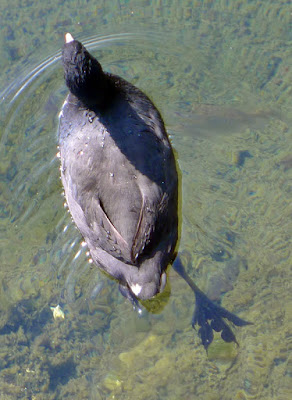 |
| Karl’s Garden, oil on canvasboard, by Carol L. Douglas |
In towns like Camden, ME or Freeport, Grand Bahamas there are year-round residents, seasonal residents, and vacationers. Because painters sit or stand like great lumps of coral for long periods of time, people forget that we’re there. That means we often overhear conversation. Anywhere Americans gather on the road, I will hear a variation on the following:
“I love this place!” the passing tourist exclaims.
“You should have been here before the hurricane/market crash/election/everything got built up,” responds the seasonal resident.
Shortly, they move on to the crux of the discussion: “The problem with these people is…”
 |
| The American Coot is a seasonal visitor to the Bahamas. Some, of course, elect to stay year-round. |
I assume this conversation has been happening for as long as people have traveled for fun, and that there are variations in Chinese, Japanese, and every other language. It makes me want a gin-and-tonic on the verandah, reminding me of the sun setting on the British Empire, of
Henry James and
Rudyard Kipling.
 |
| Wiped out. I didn’t like the composition. |
Normally, I enjoy listening to it, but I was off my game on Friday. Of course, this had nothing to do with the conversation and everything to do with composition. There is nothing inherently interesting in the shape of inlets on low-elevation, sandy cays. Without some background architecture—jetties, buildings, boats, trees—they are simply a boring ellipse that barely changes color.
On the other hand, the water itself is gorgeous. I want the opportunity to solve this dilemma, but the beach here is too hot for us pasty northerners. We take quick photos and then retreat to the shade of the palms.
 |
| Palm and sand, oil on canvasboard, by Carol L. Douglas |
We’ve been warmly welcomed by
Eva and Karl Dehmel, who have invited us to paint at their beachfront house twice. Here the conversation bounces along far less predictable pathways. I wrote about
Eva’s artwork last week; Karl is also a retired doctor and an avid gardener. Were I not on a mission, I’d have been among the palms with him and his machetes.
Karl has a light hand with the jungle, allowing it to sprawl about in its tropical way. The sky holes and traps are very different from those created by northern deciduous trees. I have been painting much more intuitively than normal, eschewing any kind of compositional sketch or pencil drawings. The subject seems to bring out the
Fauvist in me.
 |
| Boat, oil on canvasboard, by Carol L. Douglas |
“It looks kind of like a
Paul Gauguin,” my husband mused, when I showed him
Karl’s Garden.
“I think it looks more like a Tommy Bahama shirt,” I responded.
Alas, all good things come to an end, and we said our final goodbyes to Karl and Eva on Sunday evening. As we headed back toward Freeport, I noticed that I was coming out in hives. It was too late to get to the grocery store, which closes at six, and we’d just left the company of two doctors. Talk about bad timing.
 |
| The scope of our activities. |
I’m an old hand at allergies, however. I figured I could make it through the night without an antihistamine. “You don’t want to go to a Bahamian hospital if you can help it,” Cali Veilleux had told us.
By 11 PM, I was covered with bumps and my lips were swollen. I slathered myself with aloe and debated waking up
Bobbi Heath to take me to the Emergency Room. Whether it was a food, bug spray, sunscreen, the sun itself, or something environmental, I’m still swollen and itchy this morning. In a few minutes, however, we can pop over to the store and get some Benadryl. That should be the end of that.










